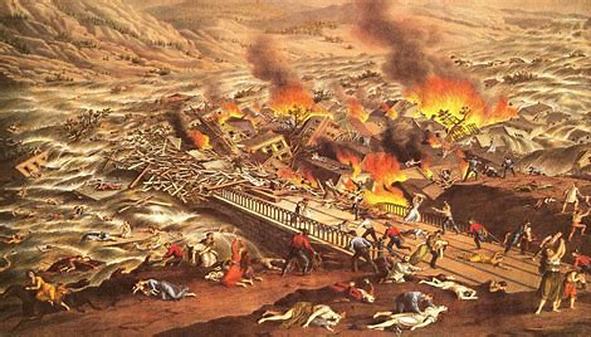|
Synopsis: The rain in Spain may fall mainly on the plain (hat tip Eliza Doolittle), but here it falls closer to the mountains. And when it gets out of control there are lessons to be learned. On the night of May 31st 1889, a line of thunderstorms crossed through Western Pennsylvania, stalled there, and formed a boundary of cool air. Meanwhile warm moist air was careening across Ohio, colliding with the stationary front and creating an unstable air mass that heaved aloft. Updrafts and countering downdrafts churned up dust inside the billowing clouds, creating pinballing pileups between micrometer-sized atmospheric dust particles. From these vortices emerged larger and larger dust particles that eventually became sizeable enough to counter the winds and obey gravity. One fell, hurtling earthward and began picking up moisture, thus becoming a raindrop. Today, meteorologists call it “training”; a series of thunderstorms that follow the same path in a seemingly endless deluge of rain. Back then, they just called it Spring. Regardless, there were many such raindrops that night. But this particular one fell, on and on, buffeted by thunderheads, toward the Conemaugh River Valley. It landed in a manmade lake created by an earthen dam built across the Little Conemaugh River. The lake was for the recreation of members in the South Fork Fishing and Hunting Club, mostly local elites, names like Frick and Carnegie, who came in the summer to get way from the industrial clamor of nearby Pittsburgh. They owned the land and had built the dam. The raindrop mixed and mingled with untold numbers of others, sloshing against the eight-year-old barrier. While some moved against the base, this raindrop rode atop small whitecaps on the lake, slamming into the gravel embankment at the top of the dam. And then spilling over it. It was the first of many, leading the way over and down, creating a breach that, along with the mass of water working below the surface, wore away the structure in a few seconds and sent it hurtling down the river valley. The raindrop now rushed in a torrent, ripping past workers who had been struggling to repair the barrier, pulling them under a massive thirty-foot wall of water. Then it swept through small towns and villages, so used to occasional flooding, that they largely ignored riders who warned them of what was coming. Then, this raindrop, this particle of the sky, who could have watered crops and given life, instead took life on a massive scale. To be fair, it had help. About 20 million tons of water swept into Johnstown, Pennsylvania at 4:07 PM. It took ten minutes for all of it to get through town as it cleared away the northern half of the city, washing wreckage toward the Stone Bridge south of town where debris piled overhead and inexplicably caught fire. The raindrop continued on down river, joining with the Allegheny, then the Ohio in Pittsburgh and finally to the Mississippi and on to the Gulf of Mexico. In its wake, were over 2,000 fatalities, crushed or drowned, by the Great Johnstown Flood. Though recriminations and relief workers (including the Clara Barton, founder of the American Red Cross) came fast, Johnstown would continue to be prone to flooding. In 1936, spring melts from the Alleghenies flowed into the Conemaugh river valley, flooding the town and killing about two dozen people. Two floods in fifty years were enough for many residents who simply packed up and left for less soggy pastures. Franklin Roosevelt rallied the Federal Government to take control of flood zones and build infrastructure to relieve the flash flood potential, basically proclaimed Johnstown a flood proof city by 1938. He couldn’t be reached for comment in 1977 when the city sat under eight feet of water. Politicians, though pretty good at knowing which way the wind is blowing, are no better than the rest of us at stopping the rain. Weather, like a capital market is a complex system- hard to predict and full of surprises. Here are a couple of lessons, learned the hard way, that we shouldn’t let be washed out of the record:
Bottom line? Expect the best but prepare for the worst. If, that is, you want to have more than just a drop in the bucket for your retirement. Photo: Bing.com Images- Free to Share & Use
Links & Sources: 1. https://www.history.com/this-day-in-history/the-johnstown-flood-2 2. https://www.weather.gov/ctp/77JohnstownFlood 3. https://physics.aps.org/story/v7/st14 4. https://theconstructor.org/water-resources/failure-of-earthfill-dams/2287/ 5. McCullough, David. The Johnstown Flood. Simon & Schuster (1968).
0 Comments
|
Don't wait for history to happen...Archives
November 2020
Categories
All
|

 RSS Feed
RSS Feed